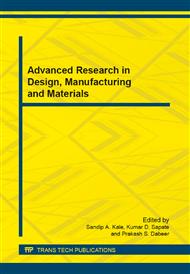p.105
p.111
p.117
p.123
p.131
p.139
p.145
p.151
p.157
Imperata cylindrica / Sacred Grass Long Fibre Reinforced Polyester Composites – An Experimental Determination of Properties
Abstract:
In the present work a new natural fibre i.e. sacred grass botanically called Imperata Cylindrica is introduced and it belongs to vedic grass family. The fibre is extracted by splitting method and is reinforced into the polyester matrix by hand lay-up technique for the fabrication of tensile, flexural, impact, dielectric test specimens as per ASTM procedures. Highest values of tensile strength (50.96 MPa), modulus (990.86 MPa) are observed for sacred grass fibre reinforced polyester composites at maximum volume fraction of chemically treated fibre. At 14.75 %, 35.89 % sacred grass fibre volume fraction the composites exhibited flexural strength, modulus of 43.19 MPa, 4.81 GPa respectively. Impact strength of 92.53 kJ/m2 is obtained for the composites reinforced with 34.73 % volume fraction of sacred grass fibres. The dielectric strength of the composites varies from 10 to 6.66 kV/mm for composites reinforced with fibres from minimum (6.26 %) to maximum (32.25 %) fibre content.
Info:
Periodical:
Pages:
131-137
Citation:
Online since:
August 2014
Keywords:
Price:
Сopyright:
© 2014 Trans Tech Publications Ltd. All Rights Reserved
Share:
Citation:


